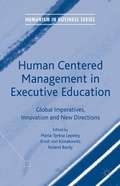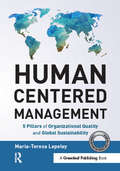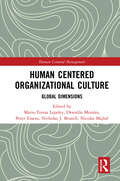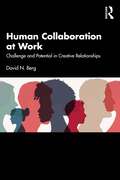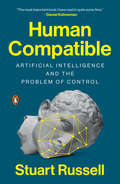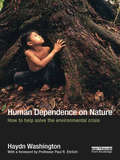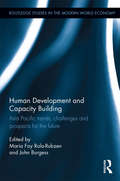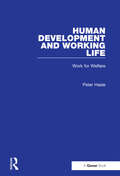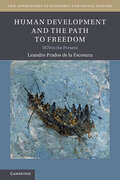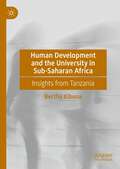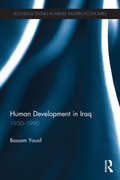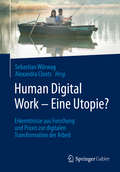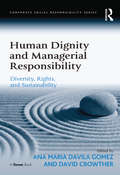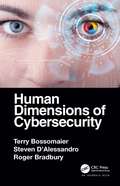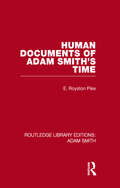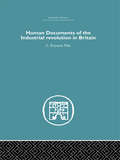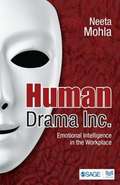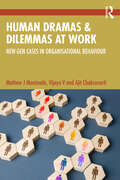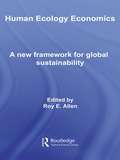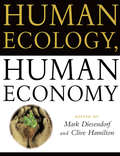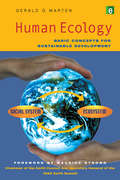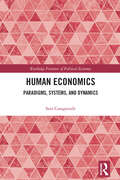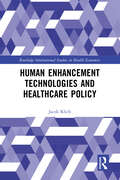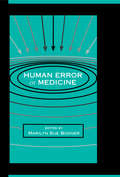- Table View
- List View
Human Centered Management in Executive Education: Global Imperatives, Innovation and New Directions (Humanism in Business Series)
by Maria-Teresa Lepeley Roland Bardy Ernst KimakowitzHuman Centered Management in Executive Education provides a comprehensive insight on innovation in Executive Education with a unique global scope. The book integrates studies and experiences of 32 distinguished scholars from 15 countries who are working in the development of theories and practices to advance the human centered management paradigm, sustainability-based quality standards and continuous improvement in education. The discussion presents a well-balanced outlook that combines and contrasts research and programs from 16 developed and 16 developing countries, and the visions of 10 female and 22 male authors from North America, South America, Europe, Asia, the Middle East and Africa.
Human Centered Management: 5 Pillars of Organizational Quality and Global Sustainability (Human Centered Management)
by Maria-Teresa LepeleyWe have never had more freedom to acquire information to make decisions, and organizations have never been so pressed to demonstrate accountability as they communicate with better informed customers and users. People who work IN an organization must also work FOR the organization to accomplish its mission. In this environment, humans are no longer just a resource; they are the reason an organization exists. New constructs are needed to ensure this human-centered paradigm shift.This book sets out the rationale for this shift and stimulates the discussion and the discovery of effective approaches and solutions to innovate for social and environmental good. Written by an expert in quality standards, the book offers a coherent model which synchronizes the organizational structure with the talent required to develop resilient and agile work environments. New strategies to develop talent will be critical, and multidisciplinary approaches from scholars and practitioners from around the world will be required to effectively collaborate and articulate the solutions. The proposition in the book focuses on continuous improvement and interdisciplinary collaboration between scholars and practitioners across different industries, sectors, and national borders in order to address the unavoidable disruptions in the global VUCA environment.
Human Centered Organizational Culture: Global Dimensions (Human Centered Management)
by Maria-Teresa LepeleyThis book is part of the Human Centered Book Trilogy, the 2021 volumes of the Routledge Human Centered Management HCM Series. HCM books are pioneering transformation from the traditional humans-as-a-resource approach of the industrial past, to the humans at the center management and organizational paradigm of the 21st century. HCM is built on talent and wellbeing of people in the workplace driving work engagement, quality standards, high performance and productivity for long-term organizational sustainability in the global VUCA (volatile, uncertain, complex, ambiguous) environment. This book was carefully crafted by recognized international human centered scholars from four continents. Although all organizations seek to have an optimal culture, unstoppable disruptions in the VUCA environment easily derail even the best efforts. Conventional assumptions of culture as a unifying organizational force are hardly defendable today. HCM maintains that culture is not only about cohesiveness and consensus but effective management of conflict and disagreements continuously testing the capacity of people to work together. This book is about organizational transformation positioning people at the center. Complementary chapters integrate as antidotes to overcome disruptions in the VUCA environment and the effects of the COVID-19 pandemic affecting people and organizations worldwide. This and its two complementary titles Soft Skills for Human Centered Management and Global Sustainability and Sensible Leadership: Human Centered, Insightful and Prudent are timely readings for leaders, managers, researchers, academics, practitioners, students and the general public responsible for organizations across industries and sectors worldwide pursuing quality standards and organizational transformation to attain sustainability.
Human Collaboration at Work: Challenge and Potential in Creative Relationships
by David N. BergHuman Collaboration at Work delves into the dynamics of collaboration between two individuals, examining both the challenges and potential in creative relationships and offering a useful resource for all those working with others. The two-person relationship is one of the key building blocks in our understanding of relationships in organizations yet is largely understudied in the literature.This book brings the dyadic relationship to the fore and offers support for those engaging in collaborative relationships in the workplace and beyond. The author reframes challenges as opportunities for partners to leverage their differences and overcome potential conflicts. Through this lens, he provides a nuanced understanding of the interpersonal and contextual factors that influence collaboration.Supported by compelling real-life examples, including the author’s own long-term working relationship with a colleague, this book is an essential guide for those in leadership roles, managers, consultants, and academics alike – anyone seeking to enhance their collaborative relationships in professional settings.
Human Compatible: Artificial Intelligence and the Problem of Control
by Stuart Russell"The most important book I have read in quite some time" (Daniel Kahneman); "A must-read" (Max Tegmark); "The book we've all been waiting for" (Sam Harris)A leading artificial intelligence researcher lays out a new approach to AI that will enable us to coexist successfully with increasingly intelligent machinesLonglisted for the 2019 Financial Times/McKinsey Business Book of the Year AwardIn the popular imagination, superhuman artificial intelligence is an approaching tidal wave that threatens not just jobs and human relationships, but civilization itself. Conflict between humans and machines is seen as inevitable and its outcome all too predictable. In this groundbreaking book, distinguished AI researcher Stuart Russell argues that this scenario can be avoided, but only if we rethink AI from the ground up. Russell begins by exploring the idea of intelligence in humans and in machines. He describes the near-term benefits we can expect, from intelligent personal assistants to vastly accelerated scientific research, and outlines the AI breakthroughs that still have to happen before we reach superhuman AI. He also spells out the ways humans are already finding to misuse AI, from lethal autonomous weapons to viral sabotage. If the predicted breakthroughs occur and superhuman AI emerges, we will have created entities far more powerful than ourselves. How can we ensure they never, ever, have power over us? Russell suggests that we can rebuild AI on a new foundation, according to which machines are designed to be inherently uncertain about the human preferences they are required to satisfy. Such machines would be humble, altruistic, and committed to pursue our objectives, not theirs. This new foundation would allow us to create machines that are provably deferential and provably beneficial.In a 2014 editorial co-authored with Stephen Hawking, Russell wrote, "Success in creating AI would be the biggest event in human history. Unfortunately, it might also be the last." Solving the problem of control over AI is not just possible; it is the key that unlocks a future of unlimited promise.
Human Creativity: The Starting Point of Innovation
by Harvard Business Review PressInnovation is the process that applies a creative idea to development of a useful product, service, process, business model, or practice. Creativity is, therefore, the starting point of innovation. But how does creativity work on an individual level? This chapter addresses a number of myths about creativity and provides tips for managing for greater individual creativity and increasing your own creativity. This chapter was originally published as chapter 11 of "Harvard Business Essentials: The Innovator's Toolkit."
Human Dependence on Nature: How to Help Solve the Environmental Crisis
by Haydn WashingtonHumanity is dependent on Nature to survive, yet our society largely acts as if this is not the case. The energy that powers our very cells, the nutrients that make up our bodies, the ecosystem services that clean our water and air; these are all provided by the Nature from which we have evolved and of which we are a part. This book examines why we deny or ignore this dependence and what we can do differently to help solve the environmental crisis. Written in an accessible and engaging style, Haydn Washington provides an excellent overview of humanity’s relationship with Nature. The book looks at energy flow, nutrient cycling, ecosystem services, ecosystem collapse as well as exploring our psychological and spiritual dependency on nature. It also examines anthropocentrism and denial as causes of our unwillingness to respect our inherent dependence on the natural environment. The book concludes by bringing these issues together and providing a framework for solutions to the environmental crisis.
Human Development and Capacity Building: Asia Pacific trends, challenges and prospects for the future (Routledge Studies in the Modern World Economy)
by John Burgess Maria Fay Rola-RubzenCapacity building looks at developing the infrastructure, institutions and people and is critical to the development and participation of humans in the economy and society. Capacity building ranges from schools, roads and hospitals through to health and welfare systems, education, communication and information sharing, participation and voice, governance and opportunity. This book aims to outline the nature and scale of the capacity building challenges facing countries in the Asia Pacific region. Human Development and Capacity Building presents case studies from selected countries with an emphasis on rural development and programs that enhance opportunity and participation in the economy. It focuses on issues arising from women development in Pakistan, indigenous union voice in the French Pacific, job creation programs in Indonesia and the role of international aid and labour agencies in capacity building in Myanmar. The rich coverage will be of invaluable use to those interested in capacity building.
Human Development and Working Life: Work for Welfare
by Peter HasleHuman Development and Working Life - Work for Welfare explores whether the development of human resources at company level can improve individuals' quality of life, company's possibilities of development, and welfare and democracy in society. The book refers to cases where attempts have been made to improve quality of working life and competitiveness of the company. Possibilities and hindrances to combine social improvements and competition in the development of human resources are discussed. During the last 10 years most European countries have increased investments in the development of human resources at work as a vehicle for social development. The public investment in training, rehabilitation and support for innovation has increased; and at the same time the labour market has been deregulated to remove obstacles for flexibility and business development. The aim of the book is to promote knowledge about how to integrate social development and flexibility at the company level.
Human Development and the Path to Freedom: 1870 to the Present (New Approaches to Economic and Social History)
by Leandro Prados de la EscosuraHow has human development evolved during the last 150 years of globalization and economic growth? How has human development been distributed across countries? How do developing countries compare to developed countries? Do social systems matter for wellbeing? Are there differences in the performance of developing regions over time? Employing a capabilities approach, Human Development and the Path to Freedom addresses these key questions in the context of modern economic growth and globalization from c.1870 to the present. Leandro Prados de la Escosura shows that health, access to knowledge, standards of living, and civil and political freedom can substitute for GDP per head as more accurate measures of our wellbeing.
Human Development and the University in Sub-Saharan Africa: Insights from Tanzania
by Bertha KibonaThis book utilises a human development and capability approach to examine the role of higher education in the context of Tanzania. The author considers decolonisation debates as they relate to African concerns in order to make a case for systems design and implementation implications for decolonising higher education institutions. The book will be of interest to students, scholars and policymakers in the field of higher education.
Human Development in Iraq: 1950-1990 (Routledge Studies in Middle Eastern Economies)
by Bassam YousifThis systematic evaluation of Iraq’s political economy and human development offers a complex and sophisticated analysis of Iraq’s recent history. Focusing on the period from 1950 up to the Gulf war in 1990, the book brings an understanding of how development has been shaped or constrained in this much misunderstood country. The author employs the human development paradigm to link human development and human rights to the analysis of political economy. The resulting scholarship, on income and investment, education and health, the status of women, and human rights, presents a nuanced, balanced - but critical - appraisal of the complex interrelationships between economic growth and development and illustrates the fragility of that development, especially when political institutions fail to keep up with the rapid expansion in human capabilities. Providing the historical analysis needed to understand Iraq’s current political situation, this book will be of great interest to scholars of development studies, Iraq, and political economy.
Human Digital Work – Eine Utopie?: Erkenntnisse aus Forschung und Praxis zur digitalen Transformation der Arbeit
by Sebastian Wörwag Alexandra ClootsDieses Buch beschreibt Chancen und Risiken für Mitarbeitende, Führungskräfte und Organisationen im Rahmen der digitalen Transformation. Mehr denn je drängen digitale Arbeits-, Organisations- und Geschäftsmodelle in die Diskussion. Sie alle suggerieren den richtigen Umgang mit der bevorstehenden Transformation. Dennoch bleibt die Ungewissheit, inwiefern einzelne Mitarbeitende in der täglichen Arbeit tangiert werden, in welchen Bereichen Technik unterstützen kann, aber auch, wo die Technik tatsächlich den Menschen in der Arbeit substituieren wird. Daher öffnet das vorliegende Buch die Diskussion zur Beantwortung folgender Fragen: Wo bleiben künftig kreative Entwicklungsräume, wenn Arbeit zunehmend standardisiert wird? Hat die klassische Führung im Zeitalter von Digitalisierung und New Work ausgedient? Für wen eröffnet die Digitalisierung Chancen? Die Beiträge des vorliegenden Sammelbands wurden beim 2. St.Galler New Work Forum präsentiert und mit 250 HR-Verantwortlichen und Wissenschaftlern diskutiert.
Human Dignity and Managerial Responsibility: Diversity, Rights, and Sustainability (Corporate Social Responsibility)
by Ana Maria GomezThe issue of human rights, in the context of corporate social responsibility, is normally taken to relate to concern about exploitation in the supply chain - child labour, slavery in developing countries, and similar evils; but of course, human rights are engaged in relation to the treatment of employees in any work situation. Indeed, as Human Dignity and Managerial Responsibility illustrates, the handling of employees is increasingly recognised as an important ingredient of sustainable enterprise - evidence shows that ethical and socially responsible behaviour is increasingly and successfully being engaged in many large corporations. Much has been written about the responsibilities of managers. Since employees are claimed by all organisations to be among their most important stakeholders it is ironic that research finds that the behaviour of many managers towards employees is often inappropriate. The editors and contributors of Human Dignity and Managerial Responsibility argue that there is a clear connection between maintaining the dignity of the workforce and corporate performance and sustainability. Their multiple perspectives on the workplace examine the position of the employee as a stakeholder, together with issues about managing employees in relation to social responsibility and sustainability. They discuss diversity in the broadest sense, filling a gap in the research-related literature essential to a more rounded understanding of CSR. Human Dignity and Managerial Responsibility will appeal to a wide audience amongst those with an academic or professional interest in CSR, sustainability, governance and stakeholder management, human rights, diversity, human resource management, and organisational development.
Human Dimensions of Cybersecurity
by Terry Bossomaier Steven D'Alessandro Roger Bradbury"In Human Dimensions of Cyber Security, Terry Bossomaier, Steven D’Alessandro, and Roger Bradbury have produced a book that … shows how it is indeed possible to achieve what we all need; a multidisciplinary, rigorously researched and argued, and above all accessible account of cybersecurity — what it is, why it matters, and how to do it." --Professor Paul Cornish, Visiting Professor, LSE IDEAS, London School of Economics Human Dimensions of Cybersecurity explores social science influences on cybersecurity. It demonstrates how social science perspectives can enable the ability to see many hazards in cybersecurity. It emphasizes the need for a multidisciplinary approach, as cybersecurity has become a fundamental issue of risk management for individuals, at work, and with government and nation states. This book explains the issues of cybersecurity with rigor, but also in simple language, so individuals can see how they can address these issues and risks. The book provides simple suggestions, or cybernuggets, that individuals can follow to learn the dos and don’ts of cybersecurity. The book also identifies the most important human and social factors that affect cybersecurity. It illustrates each factor, using case studies, and examines possible solutions from both technical and human acceptability viewpoints.
Human Documents of Adam Smith's Time (Routledge Library Editions: Adam Smith)
by Edgar Royston PikeFirst published in 1974, this is not a ‘life’ of the founder of the science of economics, although it opens with a biographical sketch; nor is it an analysis of The Wealth of Nations, although it contains numerous pointed quotations from it. Rather, it is a presentation of Adam Smith against his background of time and place, eighteenth century Britain on the eve of the Industrial Revolution. The first chapter consists of ‘documents’ illustrating life in London: ‘low life’ be it noted, which is not to say that it is all sordidness and debauchery and crime (though there is plenty of that in evidence) but life as it was lived by the ‘lower orders’, whom Adam Smith gratefully recognises as ‘the great body of the people’. The last chapter describes the Scotland that Adam Smith knew – Kirkaldy, Glasgow and Edinburgh.
Human Documents of the Industrial Revolution In Britain
by E. Royston pikeFirst Published in 2005. Routledge is an imprint of Taylor & Francis, an informa company.
Human Drama Inc.
by Neeta MohlaLife at work can be compared to a theatre where human emotions of elation, grief, happiness, winning, losing, etc., are at play. In this setting, a few lose their nerve and careers while others thrive. Success at work is not just achieved with educational qualifications, emotional intelligence is also an equal factor. Written in an anecdotal style with real-life examples, Neeta Mohla shares the script for succeeding at work. The book's practical approach is based on the author's rich experience of working with business leaders and senior executives, including the C-suite of leading organizations. Unique features of the book: * Explains EI at the workplace through real-life cases and examples, rather than focusing on the concept. * Explores the application of EI specifically in the Indian context * Engaging, conversational read with drama as the central theme * Pull-out boxes, quotes and research
Human Dramas and Dilemmas at Work: New-Gen Cases in Organisational Behaviour
by Mathew J Manimala Vijaya Venkateswaran Ajit ChakravartiThis book presents 120 real-life case-studies collected from indigenous as well as multinational organizations operating in India in 18 different industry sectors. These cases provide the readers with insights into ‘the good, the bad and the ugly’ facets of the corporate lives of new-gen professionals in the last two decades.Based on real-life work experiences of corporate executives in India, these cases address a variety of the multitude of issues being faced by the professionals and their behavioural implications at the workplace. There is considerable diversity in the themes and issues discussed in these cases. To facilitate the teaching and learning, the book provides an introductory part comprising a brief exposition of ‘OB as a discipline’. The second part of the book contains the abstracts of all cases along with questions for discussion. Thematically designed and comprehensive in coverage, the book covers almost all issues in the subject-areas of OB and HRM. The book is divided under ten sub-themes, namely: Personality, Perception and Communication, Attitudes and Values, Leadership, Power and Politics, Jobs and Roles, Conflict and Collaboration, Group and Team Dynamics, Culture and Diversity, and Managing Change. Each case is also identified under subthemes for the case facilitator to discuss, when suitable.This book will be useful to the students, academics, management researchers, industry professionals from the field of general management, organisational behaviour and human resource management and Commerce. It would also be a useful resource for professionals and the general reader as it provides an opportunity to learn through surrogate experience.
Human Ecology Economics: A New Framework for Global Sustainability (Routledge Frontiers Of Political Economy Ser.)
by Roy E. AllenThis book presentshuman ecology economics as a new and more comprehensive interdisciplinary framework for understandingworld conditions and human systems. This book helps economists rethink the boundaries and methods of their discipline - so that they can participate more fully in debates over humankinds present problems and on the ways that
Human Ecology, Human Economy: Ideas For An Ecologically Sustainable Future
by Mark Diesendorf; Clive Hamilton'A brilliant synthesis of ecology and economics that provides a sure guide to a sustainable future. It is a must for all environmentalists and economists.'Charles Birch'Written by an impressive list of experts across a number of disciplines, this readable text provides not only analysis but vigorous criticism-and answers.'Robyn Williams'This book is such a useful guide to responsible decision-making that it should be supplied in bulk to senior government officials and managers in the private sector.'Ian Lowe'This is a fine contribution to ecological economics coming from Australia, and of interest worldwide.'Herman E DalyHuman well-being is wholly dependent upon the continued good health of the Earth s ecosystems. Human behaviour as it interacts with the biophysical environment is enormously complex, as governments (and individuals) who must make decisions about resource use are becoming increasingly aware. Human Ecology, Human Economy provides the basic concepts and tools for understanding how to analyse that interaction.The book is designed to be used as a text for undergraduate and graduate students in environmental studies, human and social ecology, ecological economics, futures studies, and science and technology studies. It is also intended for interested members of the public and for policy-makers working on environmental issues, especially where these intersect with economic policy.Human Ecology, Human Economy not only covers the basic concepts, but also moves to some of the frontiers of thinking in several case studies. It uses a problem and solution oriented approach which crosses disciplinary boundaries, drawing together elements from biology, economics, philosophy and political science.Professor Mark Diesendorf is Director of the Institute for Sustainable Futures at the University of Technology, Sydney and Vice President of the Sustainable Energy Industries Council of Australia. Among the books he has edited are The Magic Bullet and Energy And People.Dr Clive Hamilton is Executive Director of the Australia Institute, Canberra and teaches in the Public Policy Program at the Australian National University. His books include Capitalist Industrialisation In Korea, The Mystic Economist and The Economic Dynamics Of Australian Industry.
Human Ecology: Basic Concepts for Sustainable Development
by Gerald G Marten'The scope and clarity of this book make it accessible and informative to a wide readership. Its messages should be an essential component of the education for all students from secondary school to university... [It] provides a clear and comprehensible account of concepts that can be applied in our individual and collective lives to pursue the promising and secure future to which we all aspire' From the Foreword by Maurice Strong, Chairman of the Earth Council and former Secretary General of the United Nations Conference on Environment and Development (Earth Summit) The most important questions of the future will turn on the relationship between human societies and the natural ecosystems on which we all, in the end, depend. The interactions and interdependencies of the social and natural worlds are the focus of growing attention from a wide range of environmental, social and life sciences. Understanding them is critical to achieving the balance involved in sustainable development. Human Ecology: Basic Concepts for Sustainable Development presents an extremely clear and accessible account of this complex range of issues and of the concepts and tools required to understand and tackle them. Extensively supported by graphics and detailed examples, this book makes an excellent introduction for students at all levels, and for general readers wanting to know why and how to respond to the dilemmas we face.
Human Economics: Paradigms, Systems, and Dynamics (Routledge Frontiers of Political Economy)
by Sara CasagrandeThe term “human economics” is sometimes used within economic theory with the hope of repositioning economic discipline as a human and social science, but with scarce success. Indeed, although great economists have always carefully considered human nature, it has been largely neglected in modern economics. This book explores the potentials of a human economics, arguing that the complexity and peculiarities of human nature should be central to the study of economics. Complex economic phenomena are subject to laws and limits that reveal their internal order in spite of the apparent randomness and unpredictability. The book embraces the contributions of thinkers and economists who have tried to fully consider human nature and society within their biological environment. From these solid foundations, the book introduces a different Weltanschauung, offers an analysis of socio-economic paradigms, and develops an alternative theoretical framework. On the basis of a transdisciplinary methodology, the book investigates human nature, interactions, and systems up to the macroeconomic cyclical development of the capitalist system. Future perspectives and issues facing modern economies are also discussed from environmental sustainability to globalization and socio-political challenges. This book marks an original contribution to the literature on retooling economic discipline and presents useful food for thought for scholarly readers while remaining accessible to graduates who are studying mainstream economics.
Human Enhancement Technologies and Healthcare Policy (Routledge International Studies in Health Economics)
by Jacek KlichHuman enhancement (HE) is considered one of the most profoundly impactful effects of the Fourth Industrial Revolution. This book presents the definition, theory, scope, and main challenges of HE from a health policy and healthcare systems perspective. It offers a comprehensive view of the consequences of human enhancement disrupting the status quo in health service delivery and social coherence.The book examines the latest achievements of HE, focusing on four forms of enhancement: cognitive, physical, mood and moral. These forms are supported by the list of specific technologies and techniques used for HE. The book identifies the current trends in HE's development and analyses the challenges that HE poses to health policy and healthcare systems. It discusses the legal and financial aspects of HE, including regulation and shows that the financing of HE goes far beyond the scope of universal health coverage, thus opening the door for private, voluntary insurance and/or out-of-pocket payments. This, in turn, leads towards growing inequalities, which may threaten social cohesion. Readers will receive a structured picture of the latest advances in HE and trends in the field, as well as a list of the challenges and problems that HE generates.The book offers a concise picture of HE for students and researchers across the political sciences, public health, public sector management, and sociology. It will also find an audience among healthcare managers, policymakers, and those who are interested in social change.
Human Error in Medicine (Human Error and Safety)
by Marilyn Sue BognerThis edited collection of articles addresses aspects of medical care in which human error is associated with unanticipated adverse outcomes. For the purposes of this book, human error encompasses mismanagement of medical care due to: * inadequacies or ambiguity in the design of a medical device or institutional setting for the delivery of medical care; * inappropriate responses to antagonistic environmental conditions such as crowding and excessive clutter in institutional settings, extremes in weather, or lack of power and water in a home or field setting; * cognitive errors of omission and commission precipitated by inadequate information and/or situational factors -- stress, fatigue, excessive cognitive workload. The first to address the subject of human error in medicine, this book considers the topic from a problem oriented, systems perspective; that is, human error is considered not as the source of the problem, but as a flag indicating that a problem exists. The focus is on the identification of the factors within the system in which an error occurs that contribute to the problem of human error. As those factors are identified, efforts to alleviate them can be instituted and reduce the likelihood of error in medical care. Human error occurs in all aspects of human activity and can have particularly grave consequences when it occurs in medicine. Nearly everyone at some point in life will be the recipient of medical care and has the possibility of experiencing the consequences of medical error. The consideration of human error in medicine is important because of the number of people that are affected, the problems incurred by such error, and the societal impact of such problems. The cost of those consequences to the individuals involved in medical error, both in the health care providers' concern and the patients' emotional and physical pain, the cost of care to alleviate the consequences of the error, and the cost to society in dollars and in lost personal contributions, mandates consideration of ways to reduce the likelihood of human error in medicine. The chapters were written by leaders in a variety of fields, including psychology, medicine, engineering, cognitive science, human factors, gerontology, and nursing. Their experience was gained through actual hands-on provision of medical care and/or research into factors contributing to error in such care. Because of the experience of the chapter authors, their systematic consideration of the issues in this book affords the reader an insightful, applied approach to human error in medicine -- an approach fortified by academic discipline.
